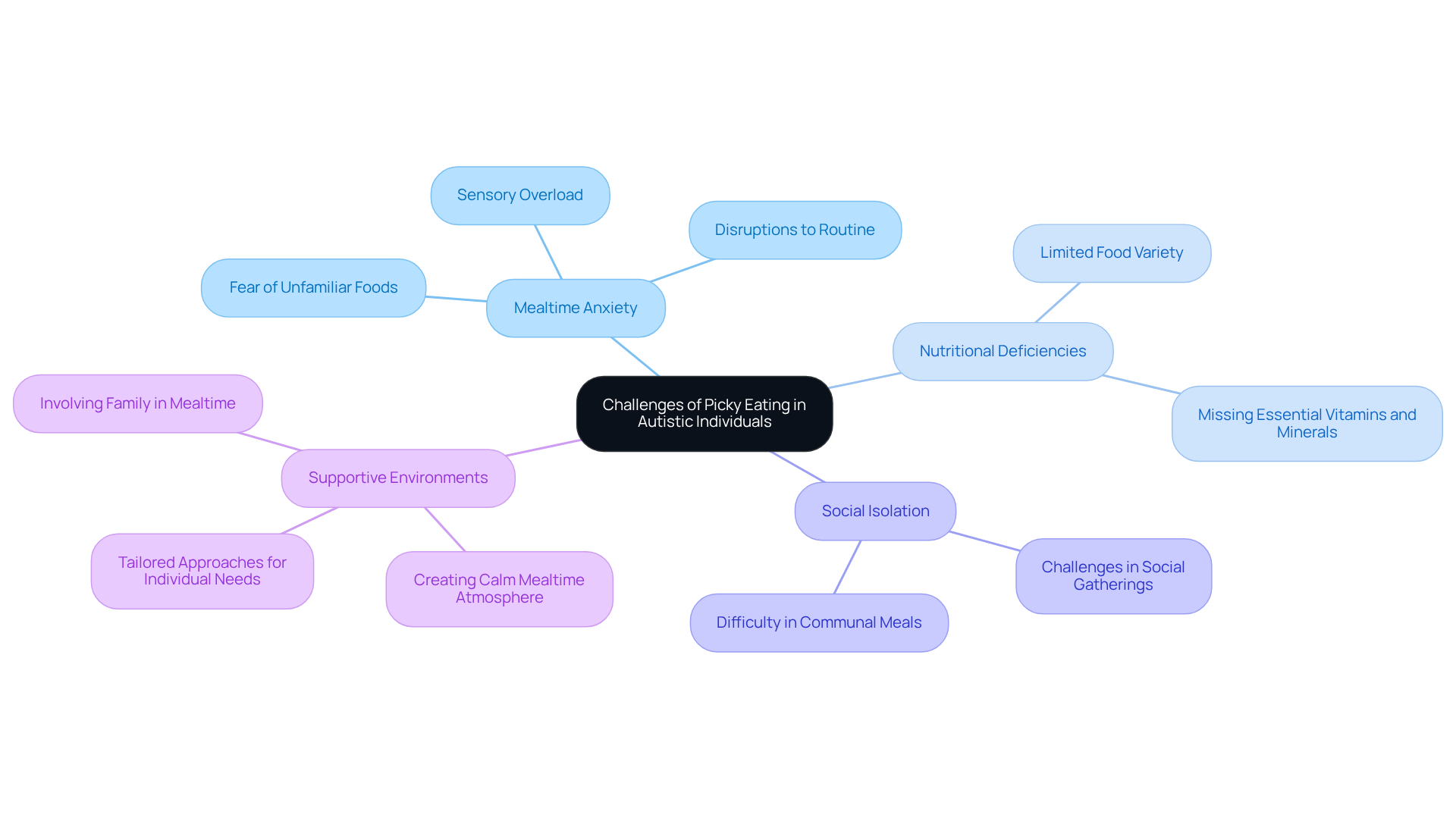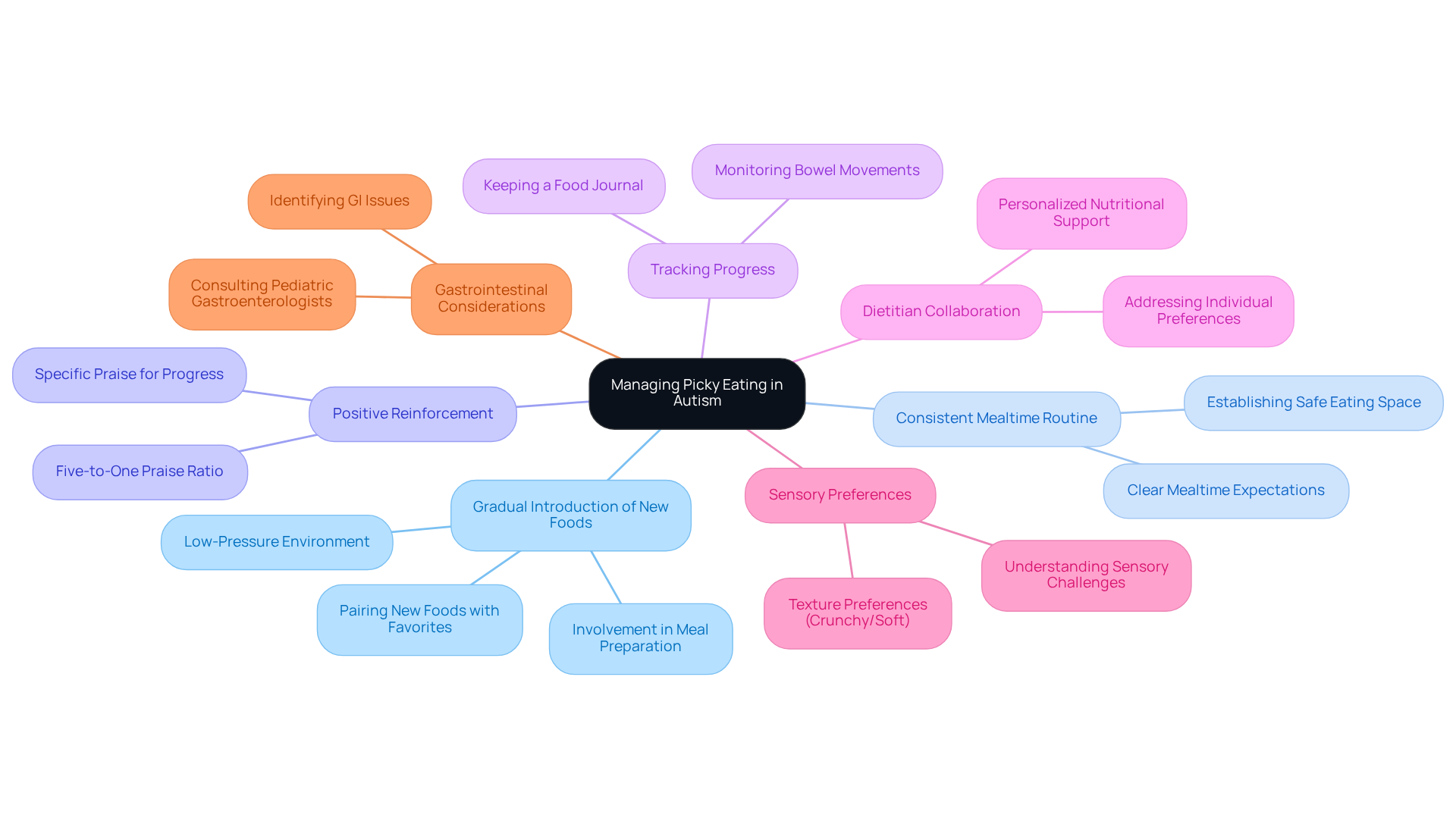Overview
This article delves into the unique challenges and strategies surrounding picky eating in individuals with autism. It highlights how their selective eating behaviors differ from those of typical picky eaters, largely due to sensory sensitivities and anxiety. Understanding these differences is crucial for parents and caregivers navigating mealtimes with their children.
Research indicates that selective eating is prevalent among autistic individuals, with emotional and nutritional implications that can significantly affect their well-being. This can be a source of concern for many parents, who may feel overwhelmed by the complexities of their child's eating habits. However, there are effective strategies that can help.
For instance:
- Gradual food introduction can ease anxiety and build a more positive relationship with food.
- Creating supportive mealtime environments is another key strategy that fosters comfort and encourages exploration of new foods.
By implementing these approaches, caregivers can make mealtimes less stressful and more enjoyable for everyone involved.
As you navigate this journey, remember that you are not alone. Many parents face similar challenges, and sharing your experiences can be incredibly valuable. Consider reaching out to support groups or online communities where you can connect with others who understand what you're going through. Together, we can foster a more nurturing environment for our children and help them thrive.
Introduction
Understanding the complexities of picky eating among autistic individuals unveils a deeper layer of challenges that goes beyond simple food preferences. While many children may display selective eating behaviors, those on the autism spectrum often encounter unique hurdles influenced by sensory sensitivities, anxiety, and rigid routines. This article delves into effective strategies to support autistic children in overcoming these eating challenges, offering insights into tailored approaches that can promote healthier eating habits.
How can caregivers navigate the intricate landscape of autism-related picky eating to ensure their children receive the nutrition they need while honoring their individual sensitivities?
Distinguishing Autism Picky Eating from General Picky Eating
Selective food preferences are a common concern for many young individuals, but for those on the autism spectrum, the reasons behind these behaviors can be quite different, especially regarding food for autism picky eaters. While typical selective eaters might avoid certain foods due to taste, texture, or appearance—often influenced by developmental stages or personal likes—autistic individuals often exhibit selective eating patterns that arise from sensory sensitivities, strict routines, and anxiety about certain textures or flavors. Research shows that individuals with autism are five times more likely to engage in selective eating, which illustrates the need for food for autism picky eaters, with estimates indicating that between 46% to 89% of autistic individuals face feeding challenges compared to their neurotypical peers.
For instance, a young person with autism might refuse to eat foods that are mixed together or have unusual textures, as these can lead to overwhelming sensory experiences. Sensory sensitivities significantly influence dietary choices, particularly in food for autism picky eaters, with around 69% of autistic children affected by texture, leading to strong aversions to new foods. Additionally, gastrointestinal issues can affect up to 50% of children with autism, further complicating their eating habits and contributing to food aversions due to discomfort.
Recognizing these differences is vital for parents and caregivers, as it enables the creation of tailored strategies, such as identifying suitable food for autism picky eaters, that meet the unique needs of autistic children. Seeking professional guidance can help identify any underlying issues related to selective eating, fostering a comprehensive approach to support. To introduce new foods, practical strategies include:
- Starting with familiar items
- Using visual aids
- Engaging in playful interactions with the food to alleviate anxiety and promote exploration
It's important to note that one-size-fits-all solutions may not effectively address the specific causes of selective eating, making it crucial to consider the individual sensory experiences of each child.

Challenges of Picky Eating in Autistic Individuals
The challenges associated with selective eating in autistic individuals go beyond mere dietary choices. Many autistic children may feel heightened anxiety during mealtimes, which can create stress for both the child and their caregivers. This anxiety often stems from a fear of unfamiliar foods, disruptions to routine, or sensory overload in the dining environment.
Additionally, selective eating can result in nutritional deficiencies, as children may limit their diets to a narrow range of foods, missing essential vitamins and minerals. Socially, these eating habits can isolate children from their peers, making it difficult to participate in communal meals or social gatherings.
Understanding these challenges is crucial for parents and professionals alike in creating supportive environments that encourage healthy eating habits, especially when it comes to providing food for autism picky eaters while addressing the emotional and sensory needs of autistic youth.

Effective Strategies for Managing Picky Eating in Autism
Managing selective eating in autistic individuals requires a compassionate and tailored approach that recognizes their unique needs, particularly when it comes to providing food for autism picky eaters. One highly effective strategy is the gradual introduction of new foods in a low-pressure environment. Imagine offering a new dish alongside a beloved favorite—this allows children to explore by touching, smelling, and eventually tasting at their own pace. Involving them in meal preparation can significantly boost their interest in trying new foods, as they gain a sense of ownership over their meals.
Establishing a consistent mealtime routine is vital for reducing anxiety and creating a safe eating space. Positive reinforcement, such as specific praise or small rewards for trying new foods, can serve as a powerful motivator for children to expand their dietary choices. It’s helpful to maintain a five-to-one ratio of praise to reprimands to effectively encourage positive behaviors during mealtimes.
Keeping a written record of what your child eats at each meal can aid in tracking progress and identifying challenges. Collaborating with a registered dietitian who specializes in autism can provide personalized support, ensuring that the nutritional needs are met while considering individual preferences, especially when it comes to food for autism picky eaters. Research indicates that children may require seven to twelve exposures to a new food before developing a preference, underscoring the importance of patience and persistence in this journey.
Additionally, recognizing that children on the autism spectrum may have specific sensory preferences for food textures—such as crunchy or soft—is crucial in addressing their unique challenges. Lastly, it’s essential to consider any potential gastrointestinal issues that might influence eating behaviors, as these can complicate mealtime experiences. By approaching this process with understanding and support, we can help our children navigate their eating journeys with confidence.

Conclusion
Understanding the intricacies of picky eating in autistic individuals reveals that their selective food preferences stem from sensory sensitivities, strict routines, and anxiety—factors that set them apart from typical picky eaters. Recognizing these unique challenges is essential for caregivers and professionals alike, as it allows for the development of tailored strategies that can effectively address the dietary needs of autistic children while honoring their individual experiences.
The article highlights several key strategies for managing picky eating, including:
- Gradual food introduction
- The importance of familiar items
- Maintaining a consistent mealtime routine
It also emphasizes the need for positive reinforcement and collaboration with specialists to ensure that nutritional requirements are met. By understanding the underlying causes of selective eating, caregivers can create supportive environments that foster healthy eating habits and promote exploration of new foods.
Ultimately, navigating the landscape of picky eating in autism is a journey that requires patience, understanding, and creativity. By implementing personalized strategies and remaining attuned to the sensory experiences of autistic children, caregivers can help them build confidence in their eating habits. This approach not only addresses nutritional needs but also enhances social interactions and emotional well-being, paving the way for a more inclusive dining experience.
Frequently Asked Questions
What is the difference between autism picky eating and general picky eating?
Autism picky eating is often driven by sensory sensitivities, strict routines, and anxiety about certain textures or flavors, while general picky eating may arise from developmental stages or personal likes related to taste, texture, or appearance.
How common is selective eating among individuals with autism?
Research indicates that individuals with autism are five times more likely to engage in selective eating, with estimates suggesting that between 46% to 89% of autistic individuals experience feeding challenges compared to their neurotypical peers.
What sensory factors influence the eating habits of autistic individuals?
Sensory sensitivities significantly affect dietary choices, with around 69% of autistic children having strong aversions to certain textures, which can lead to refusal of mixed foods or those with unusual textures.
Are there any gastrointestinal issues associated with autism that impact eating habits?
Yes, gastrointestinal issues can affect up to 50% of children with autism, contributing to food aversions due to discomfort.
Why is it important for parents and caregivers to recognize the differences in eating behaviors?
Recognizing these differences allows parents and caregivers to create tailored strategies that meet the unique needs of autistic children and support their selective eating patterns.
What are some practical strategies to introduce new foods to autistic children?
Effective strategies include starting with familiar items, using visual aids, and engaging in playful interactions with food to reduce anxiety and encourage exploration.
Why might one-size-fits-all solutions not be effective for addressing selective eating in autistic children?
One-size-fits-all solutions may not address the specific sensory experiences and individual needs of each child, making it essential to consider their unique preferences and challenges.




